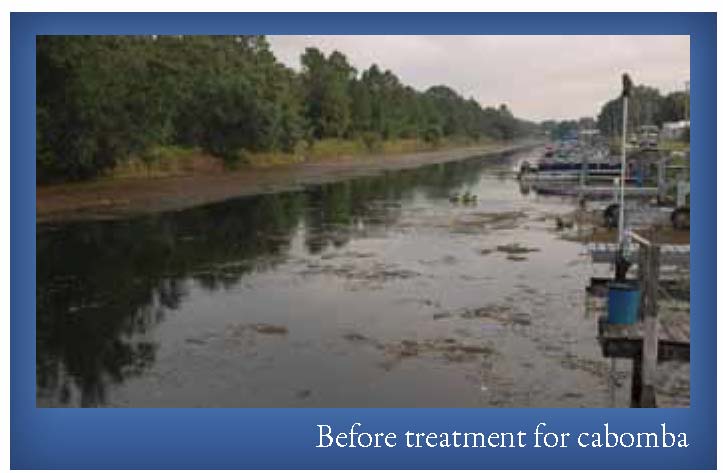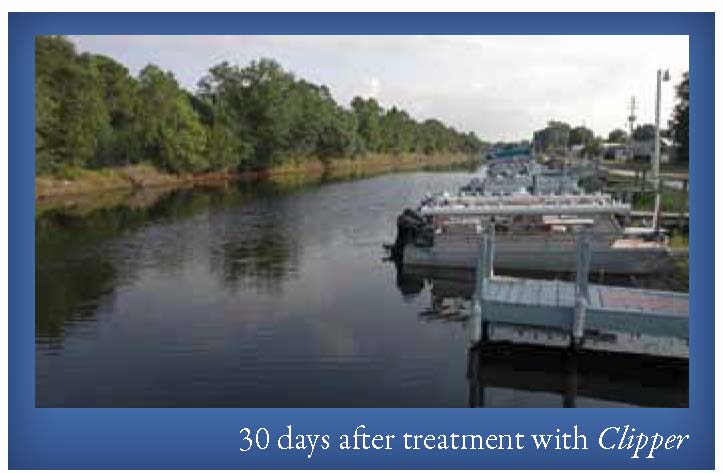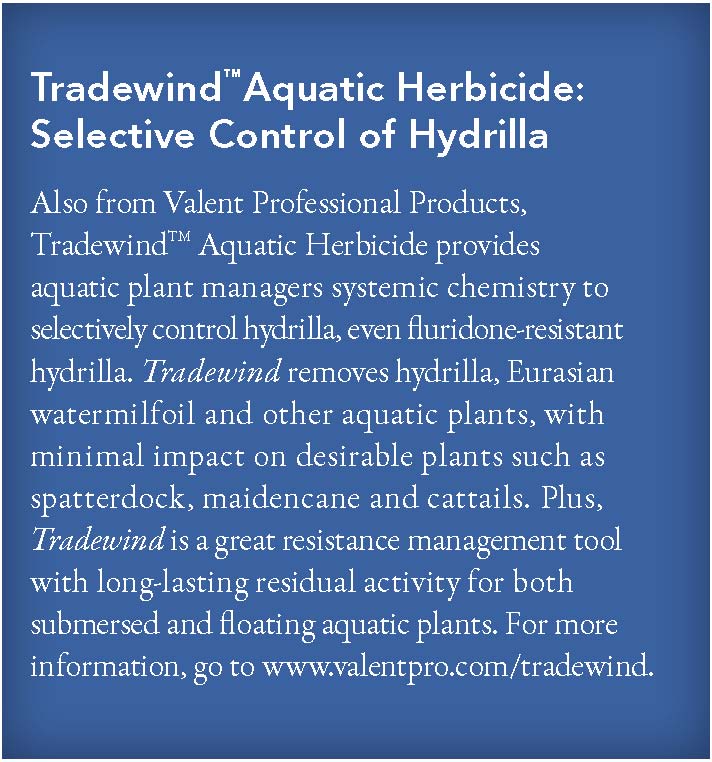Jackson Creek, Highlands County, FL >
With 200 miles of canal water under his watch as operations manager for the Central Broward County Water Control District in Davie, Fla., Bryon Boyd has battled his fair share of tough aquatic weeds. Few invasive and nuisance aquatic plant species, however, have perplexed Boyd quite like cabomba.
A fast-growing, submersed aquatic plant, cabomba (or fanwort) thrives in slow-moving waters and is difficult to eradicate once established.
“Our canals are mostly located in residential areas, and we’ve had several weeds that have been extremely hard to control, particularly cabomba and hygrophila,” Boyd said.
Registered in 2011 by the Environmental Protection Agency and approved for use in Florida, Clipper™ Aquatic Herbicide from Valent Professional Products is helping aquatic plant managers like Boyd to selectively control tough aquatic plants.
Clipper provides aquatic plant managers with a new treatment option at a time when herbicide resistance, variable response and environmental concern issues loom large.
“I think the registration of a PPO-inhibitor in aquatics is really going to help us in some of our resistance-management programs,” said Dr. Bill Haller, director of the University of Florida’s Center for Aquatic and Invasive Plants.
Haller was closely involved in early testing of Clipper and the experimental use permit (EUP) studies over the past several years. “Under EUP tests and testing under controlled conditions early on, it looked like it was controlling some species of algae and cabomba,” Dr. Haller said.
The difficulty in controlling tough invasive and nuisance aquatic plants, and the increasing resistance of some species, underscores the need for a continual flow of products with new modes of action into the marketplace.
“Having different modes of action is important for lake managers,” said Joe Bondra, president of Cygnet Enterprises, Inc., the largest single-source distributor of aquatic management products in the country. “Agriculture has rotated treatments for decades. Due in part to the limited number of choices available, we have not rotated in aquatics. Now that there will be more products with different modes of action and active ingredients, the aquatic manager will have the flexibility to rotate products as deemed appropriate.”
ROTATION PARTNERS NEEDED
Erica Van Horn, a regional biologist with the Florida Fish and Wildlife Conservation Commission (FWC), has been in need of an effective addition to her aquatic herbicide rotation program for some time.
“We’ve been using the same herbicides year after year, and what that can lead to is resistance to herbicides to the point where you’re not getting effective control anymore,” Van Horn said. “We need more herbicides that we can rotate from year to year so we don’t cause these types of resistance issues.”
Concern over the prospect of herbicide resistance is just one reason Van Horn welcomed the arrival of Clipper, which Highlands County applied in mid-May 2011 to an overwhelming mat of cabomba on Jackson Creek in what is mainly a residential area.
“We had treated previously with [another product], and we were not getting the results we wanted,” Van Horn said. “The creek was completely topped out and full of [cabomba].”
Van Horn treated eight acres with Clipper on an airboat on May 12, 2011. Within a week, the cabomba plants had noticeably browned. After 21 days, she noted that the common salvinia that had been affecting the surface of the water body had started to brown as well. By the 28-day mark, the cabomba had been completely removed.
“It was pretty effective. [Cabomba] is one of the most difficult plants to find an effective treatment for,” Van Horn said. “We were real happy, and the residents were real happy to get to be able to get their boats out. They have easy navigation now.” >
>Last spring, Alicia Knecht, a regional biologist with the FWC, used Clipper in a tank mix with diquat as part of a resistance management program for hydrilla in Central Florida’s Butler Chain of Lakes.
Being able to rotate multiple herbicides, Knecht said, “is extremely important for a system that has a long-standing history of repetitive hydrilla treatments and is being treated on a regular basis to keep it from becoming a long-term management problem.”
Until recently, however, the FWC was severely limited in terms of treatment options.
“We’ve had to use the same product for spot treatments because it was the only tool in our toolbox,” Knecht said.
The risk, of course, was that overuse of a single product could lead to resistance and leave the FWC without any viable options for small-scale hydrilla treatments.
In 2011, however, Knecht treated a pair of lakes in the Butler chain for sporadic hydrilla with a tank mix of Clipper and diquat. More than 90 days after a Clipper and diquat tank mix was applied to Lake Chase and Lake Pocket, there was still no sign of hydrilla.
“From what we have seen, the combination of the two herbicides, coupled with an even application, has resulted in a successful treatment,” Knecht said. “It’s very helpful to have another contact herbicide to use.”
Because hydrilla outbreaks in the Butler chain are so intermittent, Knecht said, “we can’t afford to lose herbicides” to resistance buildup.
“We should preserve these tools for when we really need them, rather than using them repetitively,” she said. “It’s very important to rotate herbicides because we have so few in the aquatics market and losing any of them could be detrimental to aquatic plant management.”
A BREAKTHROUGH ON THE CABOMBA FRONT
The importance of having a material that will control tough aquatic plants like cabomba and hygrophila is of the utmost importance to someone like Boyd. Some 85 percent of the canals he oversees are located in upscale neighborhoods with high expectations when it comes to aesthetics. In the past, using different products, Boyd said he could “hold cabomba at bay, but we could never kill it. That was our situation for years until we ran into Clipper.”
Last spring, Boyd applied Clipper to cabomba for the first time and experienced excellent control. In fact, Boyd found the results almost too good to be true.
“We waited 10 days after application, and when I got out there the cabomba was gone,” Boyd said. “I had doubts in my mind. I thought I was in the wrong spot.” >
Boyd soon realized what had happened.
“It came to us that the Clipper was taking the cabomba out,” he said. “It was gone. There was nothing but dirt at the bottom.”
In addition to controlling cabomba, Boyd said his Clipper application also took care of hygrophila, “which was unbelievable to us.”
The initial treatment with Clipper affected the hygrophila considerably, Boyd said, and the follow-up application took it out.
“The stuff just worked wonderfully well on cabomba,” Boyd said of Clipper. >
In addition to the efficacy of Clipper, Boyd and his applicators appreciate the fact that minimal personal protective equipment is required when applying it.
“All we had to wear was long-sleeve shirts, pants, shoes, socks and gloves,” Boyd said. “A full-body suit is just unacceptable when the heat index is 110 degrees. It made a big difference not to have to wear so much stuff.”
Because he works so closely with neighborhood residents who use the canals for recreational purposes, Boyd points to the short half-life of Clipper in the water as a key attribute.
While it is Boyd’s job to control invasive and nuisance aquatic plants, he says he’s not in the aesthetics business. When he applies products to his canals, he needs selectivity.
“I’m just so glad we finally have a product that works on some of these bad [aquatic plants] for us,” Boyd said.
With a new and effective tool to control tough aquatic plants at their disposal, Florida’s aquatic plant managers may now get a leg up in their ongoing quest for resistance management.





